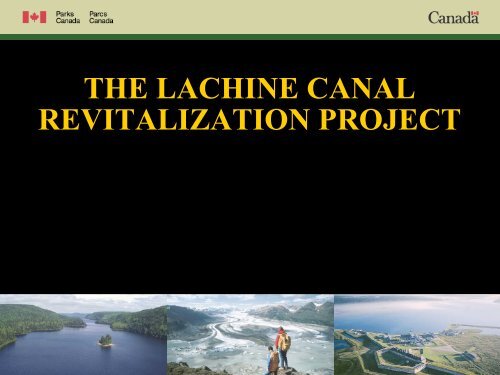Acrobat (13.5 MB/PDF) - CLU-IN
Acrobat (13.5 MB/PDF) - CLU-IN
Acrobat (13.5 MB/PDF) - CLU-IN
Create successful ePaper yourself
Turn your PDF publications into a flip-book with our unique Google optimized e-Paper software.
THE LACH<strong>IN</strong>E CANAL<br />
REVITALIZATION PROJECT
OVERVIEW<br />
Geographic and historic context<br />
Revitalization project of the Lachine Canal<br />
Environmental issues<br />
Sediments contamination monitoring program<br />
and contingency plan<br />
The impact of the new canal
Montreal…
… a city defined by its river
Montreal : a strategic location<br />
Continent<br />
MONTRÉAL<br />
Atlantic<br />
Ocean
Montreal : a strategic location<br />
Toronto<br />
CANADA<br />
Lake Ontario<br />
Kingston<br />
Ottawa<br />
Erie Canal<br />
St. Lawrence Canals<br />
U. S. A.<br />
Montreal<br />
Lachine Canal
The Lachine Rapids
THE LACH<strong>IN</strong>E CANAL
A few facts about the canal<br />
THE LACH<strong>IN</strong>E CANAL<br />
• bypasses the Lachine<br />
Rapids<br />
• is 14.5 km long<br />
• has 5 locks<br />
• shows a drop of<br />
approximately 14 m<br />
• is crossed by 23 bridges<br />
or footbridges<br />
• is a national historic site<br />
• managed by Parks Canada<br />
Agency<br />
MONTRÉAL<br />
canal<br />
rapids
A project as old as the city
Construction in 1821-1825
Enlargements in 1848 and 1885
A major transportation infrastructure
A supplier of hydraulic power
The cradle of Canadian industry
A canal that shaped the city
The St. Lawrence Seaway
Closure in 1970
Industrial decline
Decaying infrastructures
Environmental degradation<br />
Contaminated sites along the banks<br />
Over 120,000 m 3 of contaminated sediments<br />
Heavy metals, PAHs, hydrocarbons
The Lachine Canal:<br />
milestones of a national historic site<br />
1825 opening<br />
1848 1 st expansion<br />
1885 2 nd expansion<br />
1929 declared to be of<br />
national historic<br />
significance<br />
1970 closure<br />
1978 transferred to<br />
Parks Canada Agency<br />
2002 re-opened for<br />
recreational boating
Parks Canada’s mandate<br />
To commemorate,<br />
protect and present<br />
places which are<br />
significant examples of<br />
Canada's cultural and<br />
natural heritage in ways<br />
that encourage public un-<br />
derstanding, appreciation<br />
and enjoyment of this<br />
heritage, while ensuring<br />
long-term ecological and<br />
commemorative integrity
Project ultimate goal<br />
Preserving and commemorating the cultural and historical<br />
resources;<br />
Make the Lachine Canal a driving force in regional economic<br />
development once again and a substantial improvement for the<br />
local population quality of life.
Parks Canada commemorates resources that<br />
symbolize or define the national significance of<br />
this site<br />
<strong>IN</strong>DUSTRY<br />
LANDSCAPE<br />
HYDRAULIC<br />
ENERGY
Project objectives<br />
Preserve cultural/archaeological integrity<br />
Contribute to the economic and urban re-growth of<br />
Montreal South-West<br />
Bring out national heritage<br />
Re-open the canal for pleasure boating activities<br />
Complete the linear park landscaping and<br />
conveniences<br />
Clean-up contaminated sites<br />
Monitor and risk manage contaminated sediments
Environmental issues<br />
Scope of environmental assessment considers<br />
biophysical and cultural resources<br />
Main environmental issues: water quality,<br />
resuspension of contaminated sediments,<br />
preservation of commemorative integrity<br />
Joint Federal-Provincial Commission: decision not<br />
to proceed to decontamination of sediments<br />
Obligation to monitor and control impact of works<br />
and new activities, including boating
Protection of the natural environment<br />
Remediation of Parks Canada contaminated<br />
sites along the canal banks based on land use<br />
Water quality control<br />
at the source<br />
Environmental assessment<br />
of development projects<br />
and activities<br />
Sediments and suspended matter: monitoring<br />
program and risk management (contingency<br />
plan)
The original Lachine Canal Decontamination<br />
Project was studied by a joint federal-provincial<br />
Environmental commission issues<br />
Assessing the risk of sediment<br />
redispersion: on-site studies<br />
and tests with pleasure boats<br />
Before re-opening to navigation<br />
After re-opening to navigation<br />
Pleasure boating<br />
on the Lachine Canal<br />
Its recommendation was not to<br />
decontaminate, but to study and to<br />
assess the risk of redispersing sediments<br />
UNDER<br />
CRITICAL<br />
VALUES<br />
Studying the contaminated sediments:<br />
Definition of a reference level<br />
Definition of criteria and critical values<br />
Environmental monitoring<br />
and control program<br />
OVER<br />
Implementation of corrective<br />
measures if critical values are<br />
exceeded<br />
CONT<strong>IN</strong>GENCY PLAN
Reopening in May 2002
Results of monitoring program<br />
Reference level established before opening<br />
2002: 4624 boats<br />
2003: 2169 boats<br />
2004: 2340 boats<br />
No resuspension of<br />
sediments due to<br />
boating activities<br />
Increase in Cu, Pb, Zn, PAH<br />
indicative of local contamination sources<br />
Correlation between turbidity and suspended matter
Recommendations<br />
1. Turbidity tests represent<br />
a less costly, more<br />
efficient/rapid indicator<br />
2. Semi-weekly monitoring (turbidity)<br />
If threshold value exceeded,<br />
conduct point sampling SM<br />
3. Increase number of sampling<br />
stations to locate Cu, Pb, Zn,<br />
PAH discharge points
Present and future challenges<br />
Monitoring and remediation activities vs maintaining<br />
commemorative integrity, service level, visitor experience<br />
Pressures from promoters<br />
- Remediation of reserved lands<br />
- Direct access to canal<br />
Future development phases<br />
e.g. Montreal Harbourfront<br />
Vision 2025<br />
Long-term monitoring<br />
- Water quality and sediments<br />
- Reassess situation if<br />
conditions change
IMPACTS OF THE<br />
NEW CANAL
An integrating urban corridor<br />
Links 4 boroughs (Lachine, LaSalle, South-West<br />
and Ville-Marie)<br />
Establishment of an integrating<br />
green, recreational and<br />
nautical corridor<br />
1,000,000 visitors per yr<br />
A 100 M $ revitalization project<br />
Positive impact on urban renewal<br />
Is part of the Société du Havre de Montréal<br />
Montreal Harbourfront Vision 2025
Residential development
Residential development
Recreational activities
Improved environmental conditions
Improved environmental conditions
Improved environmental conditions
National Historic Site of Canada<br />
Lachine Canal<br />
End

















